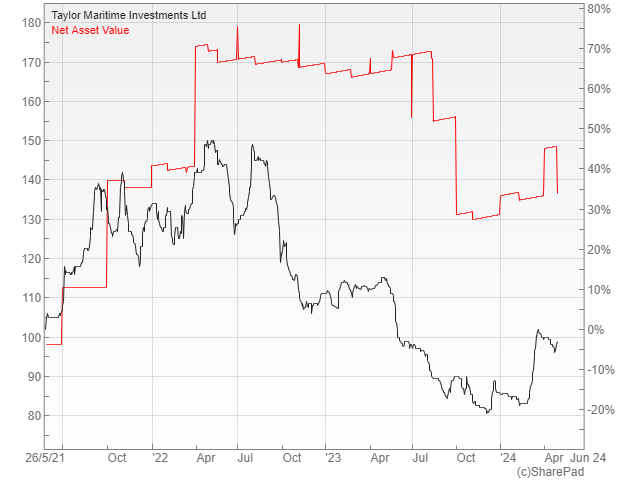Have The Shipping Trusts Hit Rock Bottom?

Many of the alternative asset classes have fallen out of favour and trade at wide discounts to NAV, with the two specialist shipping trusts being a good example. However, their latest quarterly updates look a lot more positive and suggest that there could be real value on offer, especially in view of the high yields.
The £450m Taylor Maritime (LON: TMIP) aims to provide investors with an attractive level of regular, stable and growing income and the potential for capital growth. It does this by investing primarily in dry bulk freighters that are usually employed on fixed period charters.
In December 2022 it took a controlling stake of 83.23% in the NASDAQ-listed Grindrod Shipping, which owns and operates around 20 Handysize and Supra/Ultramax vessels. This was a transformational transaction for the trust and took its combined fleet to 49 ships.
Grindrod has proposed to implement a selective capital reduction to cancel all of its shares not held by TMIP. The plan would be funded by the company’s existing cash and requires approval by a special resolution, whereupon it would become a wholly owned subsidiary.
Positive Update
Taylor Maritime’s end of March NAV was $1.48 per share, which was 8.8% higher than the equivalent figure for 31 December. Once the dividend of two cents is factored in it is equivalent to an NAV total return of 10.5%.
Most of the gain was due to an increase in the asset value of the fleet, with charter rates rising strongly due to disruption in the Panama Canal and conflict in the Red Sea. A third of the portfolio has now locked into these higher rates and is on fixed period charters for the rest of the year.
There were three sales during the quarter that were completed at an average discount of 2.5% to the figure in the accounts, with another going through post period end at a similar level. This suggests that there is real value on offer, as the shares are currently trading at around 80 pence, or a dollar, which represents a 33% discount to the latest NAV.

Do The Returns Compensate For The Risks?
On a look-through basis, the end of March debt was $328.1m, representing a 35.8% loan to gross asset value ratio. The plan is to reduce this to 25%-30% via a programme of selective disposals.
If the global economy holds up then the demand for bulk carriers should stay strong and support the higher charter rates. This is especially the case if the Red Sea remains a problem, as it is thought that the conflict results in around 85% of traffic being rerouted, with about 50% more time spent at sea.
The high leverage and economically sensitive nature of the revenues make this a risky proposition, although income investors may be tempted by the high dividends. Taylor Maritime is currently yielding 8.2% with quarterly distributions of two cents per share.
Tufton Oceanic
Its closest peer, Tufton Oceanic (LON: SHIP), has also had a decent quarter with an NAV total return of 4.5%. Operating profit was in line with expectations, but lower than the previous period due to the scheduled step down in rates on the time charters of three product tankers.
A dividend of 2.5 cents was declared, which is in accordance with SHIP’s annual target of 10 cents and is equivalent to a yield of nine percent per annum. This looks like it should be achievable as the dividend cover over the next 18 months is forecast to be about 1.6x.
The manager of the £440m trust believes that the shipping market is in a supply-driven upcycle as the forward order book for new vessels has risen to 3.5 years, which should filter through into higher prices for second hand freighters. Despite this, Tufton Oceanic is currently trading at a 25% discount to NAV.
Numis think that the shares look cheap, especially in view of the plan to return capital to shareholders. The trust faces a continuation vote this year with the Board actively looking to intervene in the market whenever the discount exceeds 10% and willing to return excess cash if it is more attractive than investing.

Comments (0)